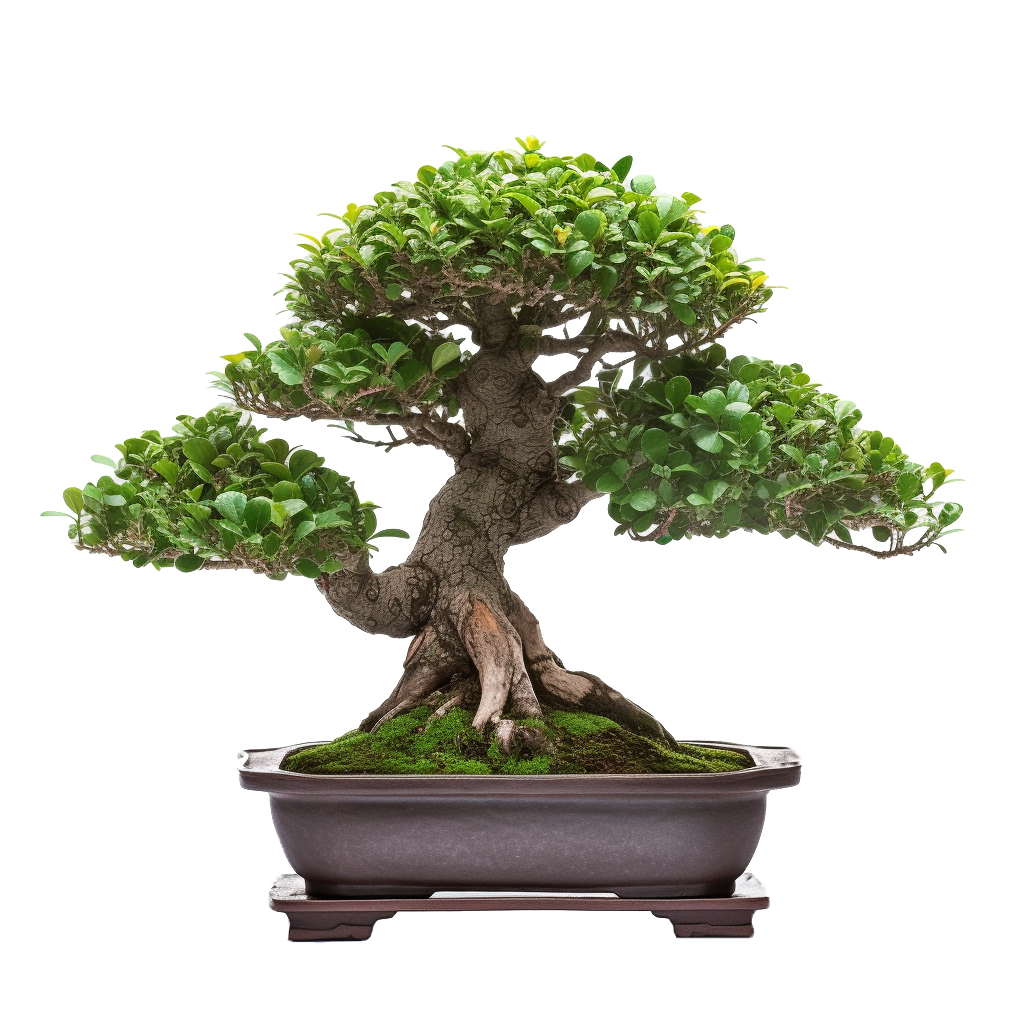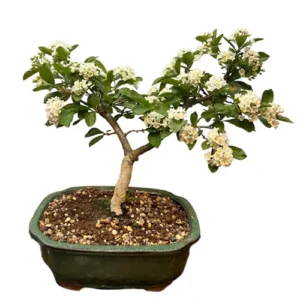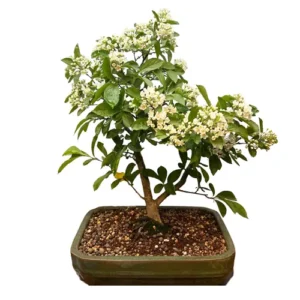Buxus Harlandii
Chinese Box Tree Bonsai
Chinese Box Tree, also commonly known as Japanese box tree, is an evergreen shrub that is native to China. It is normally used for hedging but is suitable for bonsai because of its tiny green leaves and bark that makes the tree appear much more aged than it is.

Chinese Box Tree Bonsai Care Tips
Placement
The Chinese Box Tree is quite a hardy species. Choose an outdoor location that is sunny, but it will do well somewhere semi-shaded too.
During the winter, even though in nature they are generally frost-resistant, when planted in a small pot for bonsai the roots of your box tree are at risk of freezing. We recommend protecting your box tree from frost and strong winds. Consider using a cold frame or bringing it indoors to an unheated space such as a greenhouse against the worst of the winter weather.
Watering
There is no definitive guide to watering and it should be conducted on an observational schedule, not a routine. This means that it is important to keep an eye on the moisture levels of the soil to avoid over and under watering, both which can lead to dropping leaves and/or root death. The amount of water a bonsai requires depends on pot size, climate, airflow, soil and tree type so it is best to use your eyes and fingers to assess whether the soil is damp, wet or dry.
If the top inch or so of soil has dried, it is ready to be watered. When you water, try to get an even coverage over the roots and soil, allowing water to flow out from the bottom of the pot to ensure a good soaking.
If you are a first-time bonsai owner, another way to water is by submerging the entire pot in water until the bubbles stop. If you choose this method, be aware that your bonsai may not need watering for another two to four days, but this will depend on the factors mentioned above such as soil type, pot size and climate.
Feeding & Fertilising
Using fertiliser on your Chinese Box Tree will help encourage healthy growth and this should be done periodically from once a week to every two months and only during the growing season. You can start adding Chrysal Liquid Bonsai Feed to your water from March until October and use weekly. Use Naruko Fertiliser Slow Release Bonsai Feed once every one to two months. With Chinese Box trees, less is more, and we tend to advise using half the recommended dosage to see how your Chinese Box reacts first.
Pruning & Wiring
Pruning your bonsai is important not only to maintain or create an aesthetic style but to also ensure light and airflow can reach inner leaves and the box tree tolerates constant pruning very well. During the early to late spring months use appropriate tools to cut back stems which have grown longer than four leaves, leaving the two leaves which are closest to the stem intact. You can repeat this process when new stems appear after pruning. It is easy to create ramification with the box tree simply by regular pruning in late spring. To refine the foliage, pinch out new growth for the rest of the year. The boxwood can grow very thick and bushy so thin out the inner leaves and branches to let light and air through.
Training your bonsai using wiring is best done while the branches are still soft and young. Even though the more mature branches appear as very hard-looking wood, the bark is very delicate and prone to scarring for a long time. We recommend using wires with a thickness that matches the thickness of the branch: if the wire you choose is too thick you will damage the bark. If it is too thin, it won’t be effective. Once your Chinese Box Tree is older, it is sufficient to shape it by pruning alone.
Repotting
Repotting your tree is an important way to provide a fresh and suitable soil mix and ensure appropriate root health. Repot in early spring. Generally, your Chinese Box Tree will need to be re-potted once every two years if it is young, while older ones can stay in their pots for longer. However, you should always check if it has become root-bound before you change pots. You can do this by lifting the tree gently out of the pot by the main trunk and examining the root system. You will know it is ready if you can see that the roots are circling around each other and the pot. If, however, they still appear contained in the soil, you should place it back and wait until the following spring to check again.
Trees that are ready for repotting will require root pruning, a suitable new pot and appropriate soil mix.
The roots of a Chinese Box Tree can be pruned considerably. It is important that the soil mix you choose for your Chinese box tree’s new pot is well-draining and we tend to use a mixture of different speciality bonsai soils on our trees. Every species is different so please contact us for free soil-mix advice or to take advantage of our repotting service.
Bonsai trees aren’t only magnificent additions to an indoor oasis, they are more than capable of standing out in any garden. Many Bonsai species are incredibly hardy and withstand nature’s colder and damper turns with aplomb making them worthwhile outdoor plants. We have an extensive library of care guides for outdoor bonsai trees. It’s not about selecting the perfect bonsai, it’s about selecting the perfect bonsai for you.
Chinese Box Tree Bonsai - Typical Queries
How to propagate a Chinese Box Tree Bonsai?
You can propagate a Chinese Box Tree Bonsai by taking cuttings or by air layering. Cuttings are small pieces of stem or branch that are planted in moist soil and kept in a humid environment until they root. Air layering is a technique that involves making a cut on a branch, wrapping it with moist moss and plastic, and cutting it off when roots form and cutting it off when roots form.
What are the common pests and diseases of a Chinese Box Tree Bonsai?
The common pests and diseases of a Chinese Box Tree Bonsai include aphids, scale insects, spider mites, leaf spot, root rot, and box blight. To prevent and treat these problems, you should keep your bonsai healthy, clean, and well-ventilated. You should also inspect your bonsai regularly and remove any infected or damaged parts. You can use insecticidal soap, neem oil, or fungicide to control the pests and diseases, but always test a small area first and follow the directions carefully.
When should you not trim a Chinese Box Tree Bonsai?
You should not trim a Chinese Box Tree Bonsai when it is dormant, stressed, or sick. This could weaken the bonsai and make it more susceptible to pests and diseases. You should also avoid trimming your bonsai when it is flowering, as this could reduce the number and quality of the blooms.
Can the Chinese Box Tree Bonsai be kept indoors?
The Chinese Box Tree Bonsai can be kept indoors, but it prefers to be outdoors during the summer. If you keep your bonsai indoors, you should provide it with enough light, humidity, and air circulation. You should also monitor the temperature and avoid placing your bonsai near heat sources or cold drafts. You should move your bonsai outdoors gradually, and bring it back indoors before the first frost.
Why do Chinese Box Tree Bonsai go brown?
Chinese Box Tree Bonsai can go brown for various reasons, such as overwatering, underwatering, sunburn, frost damage, nutrient deficiency, or pest and disease infestation. To prevent and treat browning, you should check the soil moisture, the exposure to sun and cold, the fertilizer application, and the signs of pests and diseases. You should also prune off the brown parts and improve the growing conditions of your bonsai.





















